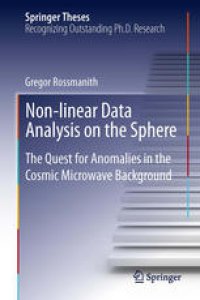
Ebook: Non-linear Data Analysis on the Sphere: The Quest for Anomalies in the Cosmic Microwave Background
Author: Gregor Rossmanith (auth.)
- Tags: Cosmology, Mathematical Methods in Physics, Statistical Physics Dynamical Systems and Complexity
- Series: Springer Theses
- Year: 2013
- Publisher: Springer International Publishing
- Edition: 1
- Language: English
- pdf
This work deals with the search for signatures of non-Gaussianities in the cosmic microwave background (CMB). Probing Gaussianity in the CMB addresses one of the key questions in modern cosmology because it allows us to discriminate between different models of inflation, and thus concerns a fundamental part of the standard cosmological model.
The basic goal here is to adapt complementary methods stemming from the field of complexity science to CMB data analysis. Two key concepts, namely the method of surrogates and estimators for local scaling properties, are applied to CMB data analysis.
All results show strong non-Gaussianities and pronounced asymmetries. The consistency of the full sky and cut sky results shows convincingly for the first time that the influence of the Galactic plane is not responsible for these deviations from Gaussianity and isotropy. The findings seriously call into question predictions of isotropic cosmologies based on the widely accepted single field slow roll inflation model.
This work deals with the search for signatures of non-Gaussianities in the cosmic microwave background (CMB). Probing Gaussianity in the CMB addresses one of the key questions in modern cosmology because it allows us to discriminate between different models of inflation, and thus concerns a fundamental part of the standard cosmological model.
The basic goal here is to adapt complementary methods stemming from the field of complexity science to CMB data analysis. Two key concepts, namely the method of surrogates and estimators for local scaling properties, are applied to CMB data analysis.
All results show strong non-Gaussianities and pronounced asymmetries. The consistency of the full sky and cut sky results shows convincingly for the first time that the influence of the Galactic plane is not responsible for these deviations from Gaussianity and isotropy. The findings seriously call into question predictions of isotropic cosmologies based on the widely accepted single field slow roll inflation model.
This work deals with the search for signatures of non-Gaussianities in the cosmic microwave background (CMB). Probing Gaussianity in the CMB addresses one of the key questions in modern cosmology because it allows us to discriminate between different models of inflation, and thus concerns a fundamental part of the standard cosmological model.
The basic goal here is to adapt complementary methods stemming from the field of complexity science to CMB data analysis. Two key concepts, namely the method of surrogates and estimators for local scaling properties, are applied to CMB data analysis.
All results show strong non-Gaussianities and pronounced asymmetries. The consistency of the full sky and cut sky results shows convincingly for the first time that the influence of the Galactic plane is not responsible for these deviations from Gaussianity and isotropy. The findings seriously call into question predictions of isotropic cosmologies based on the widely accepted single field slow roll inflation model.
Content:
Front Matter....Pages i-xii
Introduction and Theoretical Background....Pages 1-19
Methods for Testing the Non-Gaussianity of the CMB....Pages 21-44
Observations of the CMB with the WMAP Satellite....Pages 45-52
Scaling Indices Applied to the WMAP 5-Year Data....Pages 53-77
Surrogates and Scaling Indices Applied to the WMAP 7-Year Data....Pages 79-86
Extending the Analysis of the WMAP 7-Year Data....Pages 87-107
Applying the Surrogate Approach to Incomplete Skies....Pages 109-119
Conclusions....Pages 121-122
Back Matter....Pages 123-126
This work deals with the search for signatures of non-Gaussianities in the cosmic microwave background (CMB). Probing Gaussianity in the CMB addresses one of the key questions in modern cosmology because it allows us to discriminate between different models of inflation, and thus concerns a fundamental part of the standard cosmological model.
The basic goal here is to adapt complementary methods stemming from the field of complexity science to CMB data analysis. Two key concepts, namely the method of surrogates and estimators for local scaling properties, are applied to CMB data analysis.
All results show strong non-Gaussianities and pronounced asymmetries. The consistency of the full sky and cut sky results shows convincingly for the first time that the influence of the Galactic plane is not responsible for these deviations from Gaussianity and isotropy. The findings seriously call into question predictions of isotropic cosmologies based on the widely accepted single field slow roll inflation model.
Content:
Front Matter....Pages i-xii
Introduction and Theoretical Background....Pages 1-19
Methods for Testing the Non-Gaussianity of the CMB....Pages 21-44
Observations of the CMB with the WMAP Satellite....Pages 45-52
Scaling Indices Applied to the WMAP 5-Year Data....Pages 53-77
Surrogates and Scaling Indices Applied to the WMAP 7-Year Data....Pages 79-86
Extending the Analysis of the WMAP 7-Year Data....Pages 87-107
Applying the Surrogate Approach to Incomplete Skies....Pages 109-119
Conclusions....Pages 121-122
Back Matter....Pages 123-126
....